MOD003486 - Managing Human Resources: Employee Engagement Report
VerifiedAdded on 2023/06/12
|12
|3643
|138
Report
AI Summary
This report examines strategies for improving employee engagement within organizations, focusing on Marks & Spencer as a case study. It discusses methods to promote employee participation through various techniques, including office games, regular communication, and employee assistance programs. The report also highlights the importance of 'employee voice' and outlines communication strategies to foster open dialogue between employees and management. Furthermore, it addresses training and development considerations to ensure managers and staff understand their roles effectively. The analysis includes recommendations for prioritizing professional development, recognizing employee achievements, and encouraging open communication, while also acknowledging potential disadvantages such as the risk of leaking confidential information. The report aims to provide a comprehensive overview of how to create a more engaged and productive workforce.
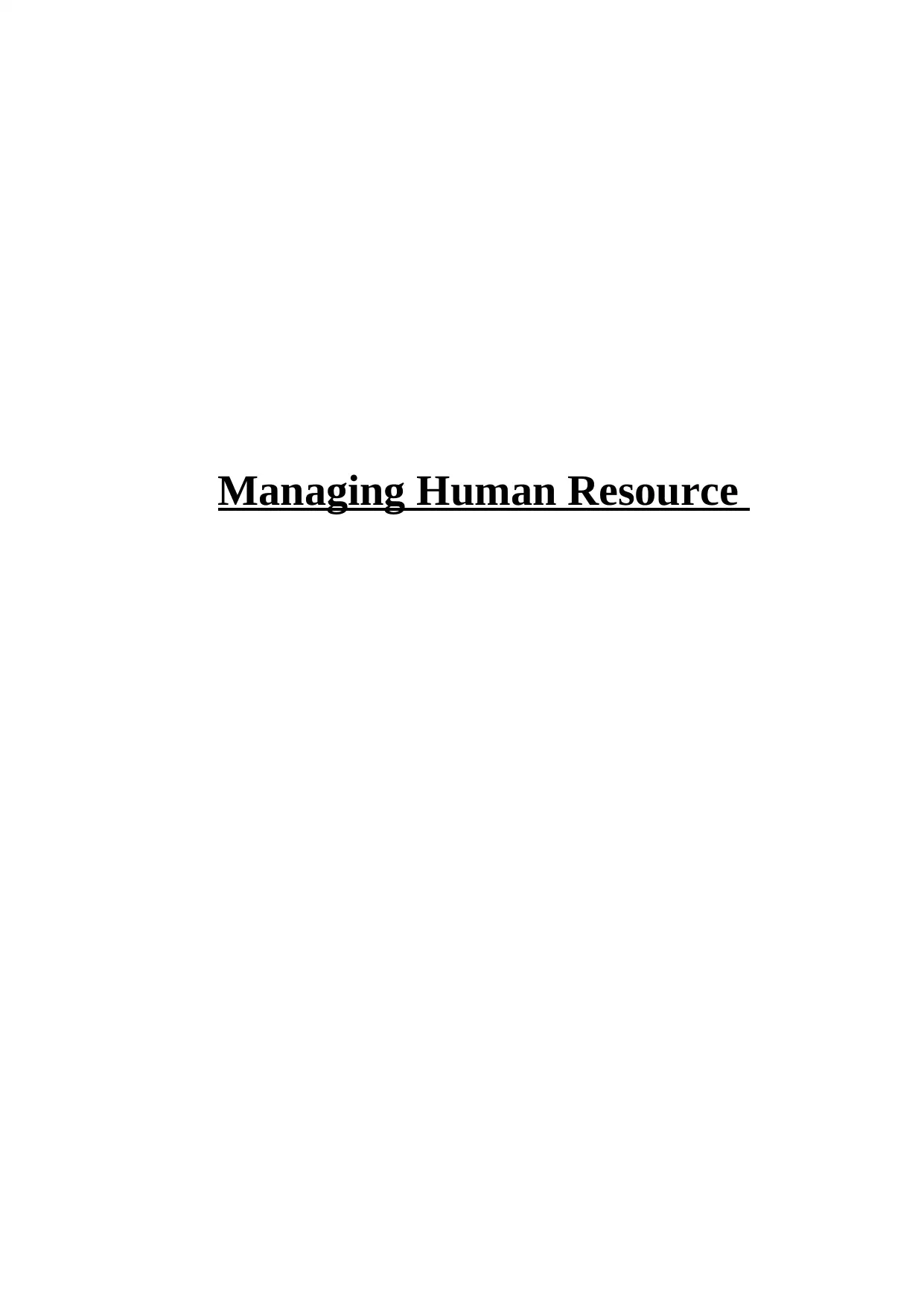
Managing Human Resource
Paraphrase This Document
Need a fresh take? Get an instant paraphrase of this document with our AI Paraphraser
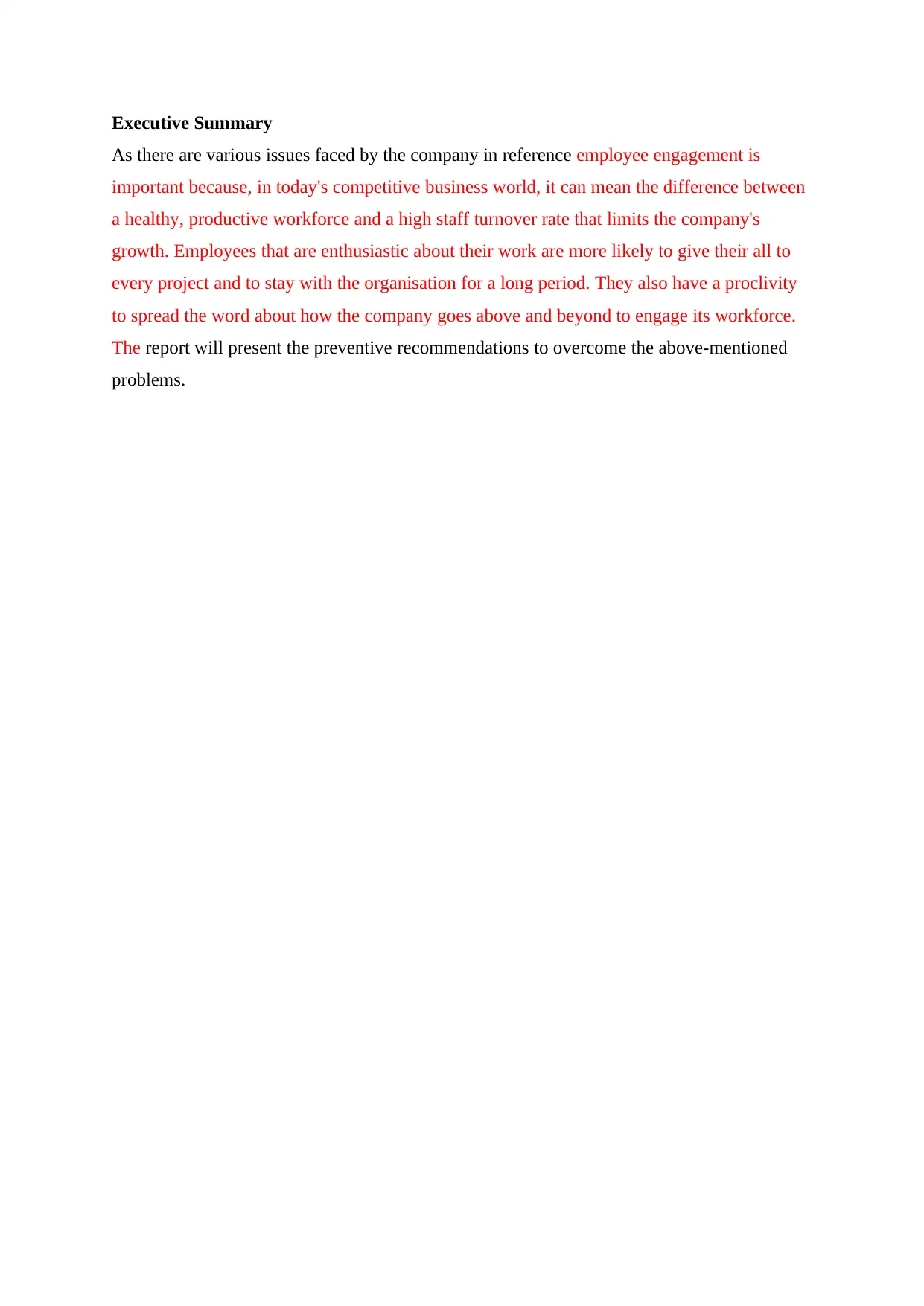
Executive Summary
As there are various issues faced by the company in reference employee engagement is
important because, in today's competitive business world, it can mean the difference between
a healthy, productive workforce and a high staff turnover rate that limits the company's
growth. Employees that are enthusiastic about their work are more likely to give their all to
every project and to stay with the organisation for a long period. They also have a proclivity
to spread the word about how the company goes above and beyond to engage its workforce.
The report will present the preventive recommendations to overcome the above-mentioned
problems.
As there are various issues faced by the company in reference employee engagement is
important because, in today's competitive business world, it can mean the difference between
a healthy, productive workforce and a high staff turnover rate that limits the company's
growth. Employees that are enthusiastic about their work are more likely to give their all to
every project and to stay with the organisation for a long period. They also have a proclivity
to spread the word about how the company goes above and beyond to engage its workforce.
The report will present the preventive recommendations to overcome the above-mentioned
problems.
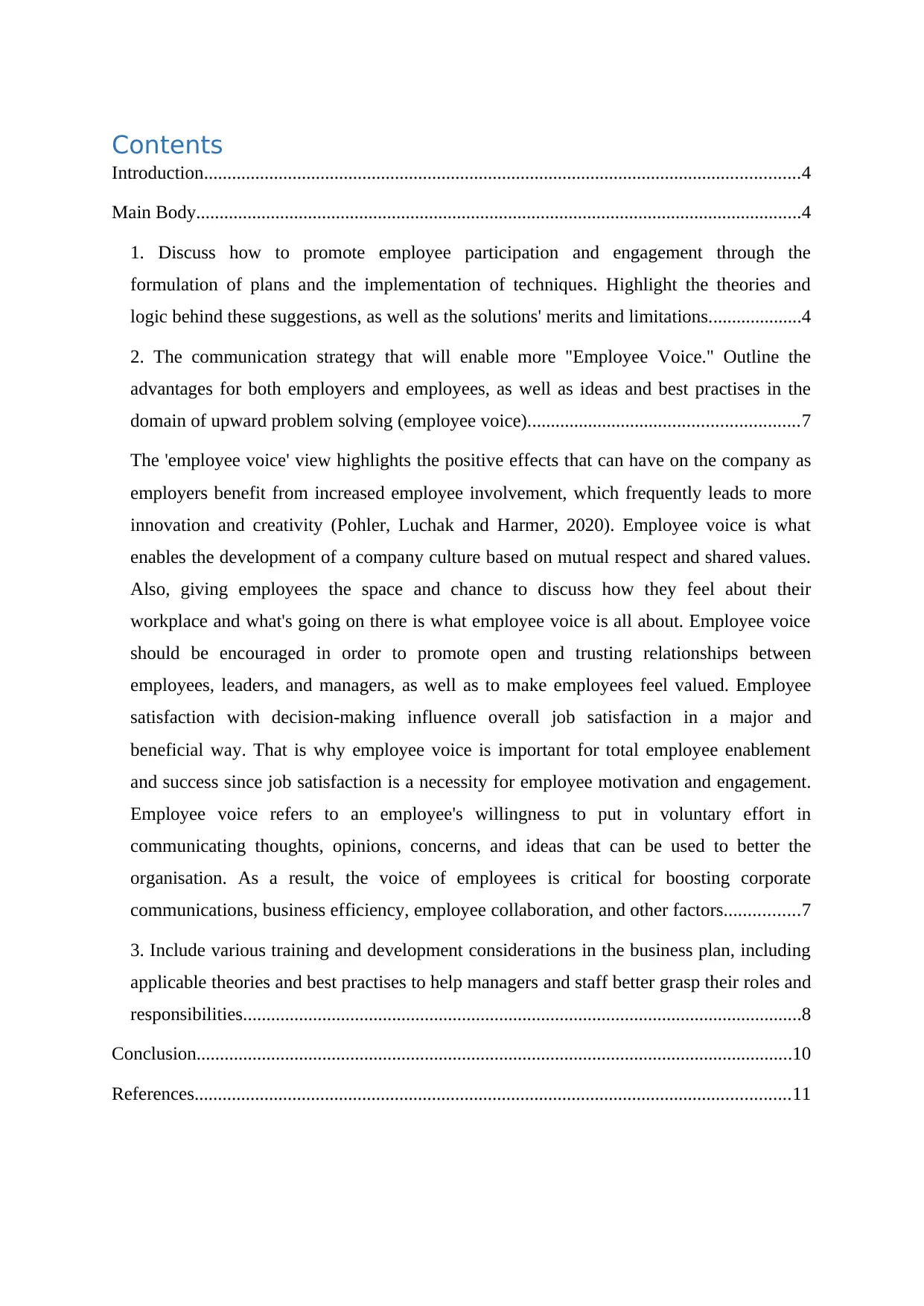
Contents
Introduction................................................................................................................................4
Main Body..................................................................................................................................4
1. Discuss how to promote employee participation and engagement through the
formulation of plans and the implementation of techniques. Highlight the theories and
logic behind these suggestions, as well as the solutions' merits and limitations....................4
2. The communication strategy that will enable more "Employee Voice." Outline the
advantages for both employers and employees, as well as ideas and best practises in the
domain of upward problem solving (employee voice)..........................................................7
The 'employee voice' view highlights the positive effects that can have on the company as
employers benefit from increased employee involvement, which frequently leads to more
innovation and creativity (Pohler, Luchak and Harmer, 2020). Employee voice is what
enables the development of a company culture based on mutual respect and shared values.
Also, giving employees the space and chance to discuss how they feel about their
workplace and what's going on there is what employee voice is all about. Employee voice
should be encouraged in order to promote open and trusting relationships between
employees, leaders, and managers, as well as to make employees feel valued. Employee
satisfaction with decision-making influence overall job satisfaction in a major and
beneficial way. That is why employee voice is important for total employee enablement
and success since job satisfaction is a necessity for employee motivation and engagement.
Employee voice refers to an employee's willingness to put in voluntary effort in
communicating thoughts, opinions, concerns, and ideas that can be used to better the
organisation. As a result, the voice of employees is critical for boosting corporate
communications, business efficiency, employee collaboration, and other factors................7
3. Include various training and development considerations in the business plan, including
applicable theories and best practises to help managers and staff better grasp their roles and
responsibilities........................................................................................................................8
Conclusion................................................................................................................................10
References................................................................................................................................11
Introduction................................................................................................................................4
Main Body..................................................................................................................................4
1. Discuss how to promote employee participation and engagement through the
formulation of plans and the implementation of techniques. Highlight the theories and
logic behind these suggestions, as well as the solutions' merits and limitations....................4
2. The communication strategy that will enable more "Employee Voice." Outline the
advantages for both employers and employees, as well as ideas and best practises in the
domain of upward problem solving (employee voice)..........................................................7
The 'employee voice' view highlights the positive effects that can have on the company as
employers benefit from increased employee involvement, which frequently leads to more
innovation and creativity (Pohler, Luchak and Harmer, 2020). Employee voice is what
enables the development of a company culture based on mutual respect and shared values.
Also, giving employees the space and chance to discuss how they feel about their
workplace and what's going on there is what employee voice is all about. Employee voice
should be encouraged in order to promote open and trusting relationships between
employees, leaders, and managers, as well as to make employees feel valued. Employee
satisfaction with decision-making influence overall job satisfaction in a major and
beneficial way. That is why employee voice is important for total employee enablement
and success since job satisfaction is a necessity for employee motivation and engagement.
Employee voice refers to an employee's willingness to put in voluntary effort in
communicating thoughts, opinions, concerns, and ideas that can be used to better the
organisation. As a result, the voice of employees is critical for boosting corporate
communications, business efficiency, employee collaboration, and other factors................7
3. Include various training and development considerations in the business plan, including
applicable theories and best practises to help managers and staff better grasp their roles and
responsibilities........................................................................................................................8
Conclusion................................................................................................................................10
References................................................................................................................................11
⊘ This is a preview!⊘
Do you want full access?
Subscribe today to unlock all pages.

Trusted by 1+ million students worldwide
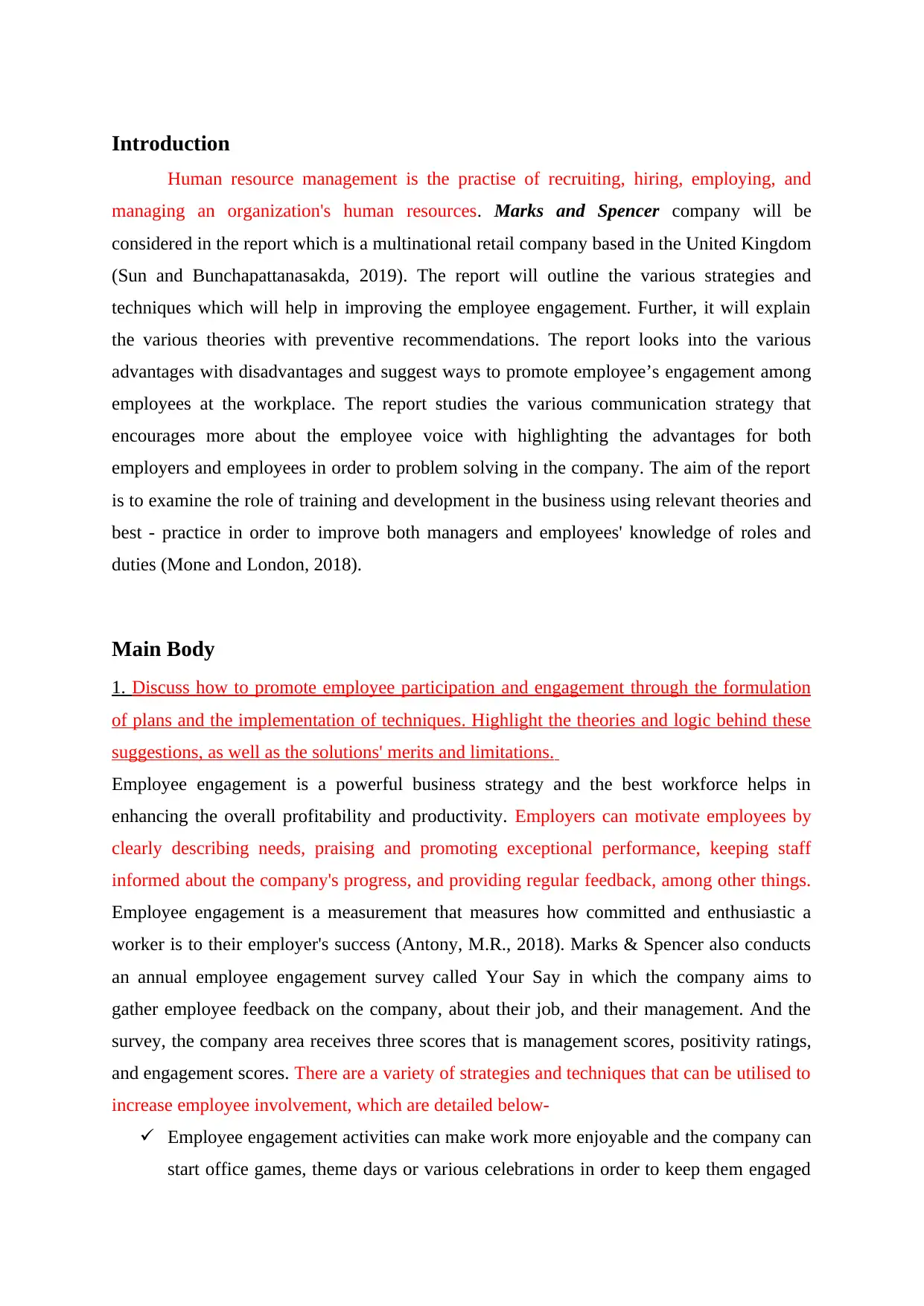
Introduction
Human resource management is the practise of recruiting, hiring, employing, and
managing an organization's human resources. Marks and Spencer company will be
considered in the report which is a multinational retail company based in the United Kingdom
(Sun and Bunchapattanasakda, 2019). The report will outline the various strategies and
techniques which will help in improving the employee engagement. Further, it will explain
the various theories with preventive recommendations. The report looks into the various
advantages with disadvantages and suggest ways to promote employee’s engagement among
employees at the workplace. The report studies the various communication strategy that
encourages more about the employee voice with highlighting the advantages for both
employers and employees in order to problem solving in the company. The aim of the report
is to examine the role of training and development in the business using relevant theories and
best - practice in order to improve both managers and employees' knowledge of roles and
duties (Mone and London, 2018).
Main Body
1. Discuss how to promote employee participation and engagement through the formulation
of plans and the implementation of techniques. Highlight the theories and logic behind these
suggestions, as well as the solutions' merits and limitations.
Employee engagement is a powerful business strategy and the best workforce helps in
enhancing the overall profitability and productivity. Employers can motivate employees by
clearly describing needs, praising and promoting exceptional performance, keeping staff
informed about the company's progress, and providing regular feedback, among other things.
Employee engagement is a measurement that measures how committed and enthusiastic a
worker is to their employer's success (Antony, M.R., 2018). Marks & Spencer also conducts
an annual employee engagement survey called Your Say in which the company aims to
gather employee feedback on the company, about their job, and their management. And the
survey, the company area receives three scores that is management scores, positivity ratings,
and engagement scores. There are a variety of strategies and techniques that can be utilised to
increase employee involvement, which are detailed below-
Employee engagement activities can make work more enjoyable and the company can
start office games, theme days or various celebrations in order to keep them engaged
Human resource management is the practise of recruiting, hiring, employing, and
managing an organization's human resources. Marks and Spencer company will be
considered in the report which is a multinational retail company based in the United Kingdom
(Sun and Bunchapattanasakda, 2019). The report will outline the various strategies and
techniques which will help in improving the employee engagement. Further, it will explain
the various theories with preventive recommendations. The report looks into the various
advantages with disadvantages and suggest ways to promote employee’s engagement among
employees at the workplace. The report studies the various communication strategy that
encourages more about the employee voice with highlighting the advantages for both
employers and employees in order to problem solving in the company. The aim of the report
is to examine the role of training and development in the business using relevant theories and
best - practice in order to improve both managers and employees' knowledge of roles and
duties (Mone and London, 2018).
Main Body
1. Discuss how to promote employee participation and engagement through the formulation
of plans and the implementation of techniques. Highlight the theories and logic behind these
suggestions, as well as the solutions' merits and limitations.
Employee engagement is a powerful business strategy and the best workforce helps in
enhancing the overall profitability and productivity. Employers can motivate employees by
clearly describing needs, praising and promoting exceptional performance, keeping staff
informed about the company's progress, and providing regular feedback, among other things.
Employee engagement is a measurement that measures how committed and enthusiastic a
worker is to their employer's success (Antony, M.R., 2018). Marks & Spencer also conducts
an annual employee engagement survey called Your Say in which the company aims to
gather employee feedback on the company, about their job, and their management. And the
survey, the company area receives three scores that is management scores, positivity ratings,
and engagement scores. There are a variety of strategies and techniques that can be utilised to
increase employee involvement, which are detailed below-
Employee engagement activities can make work more enjoyable and the company can
start office games, theme days or various celebrations in order to keep them engaged
Paraphrase This Document
Need a fresh take? Get an instant paraphrase of this document with our AI Paraphraser
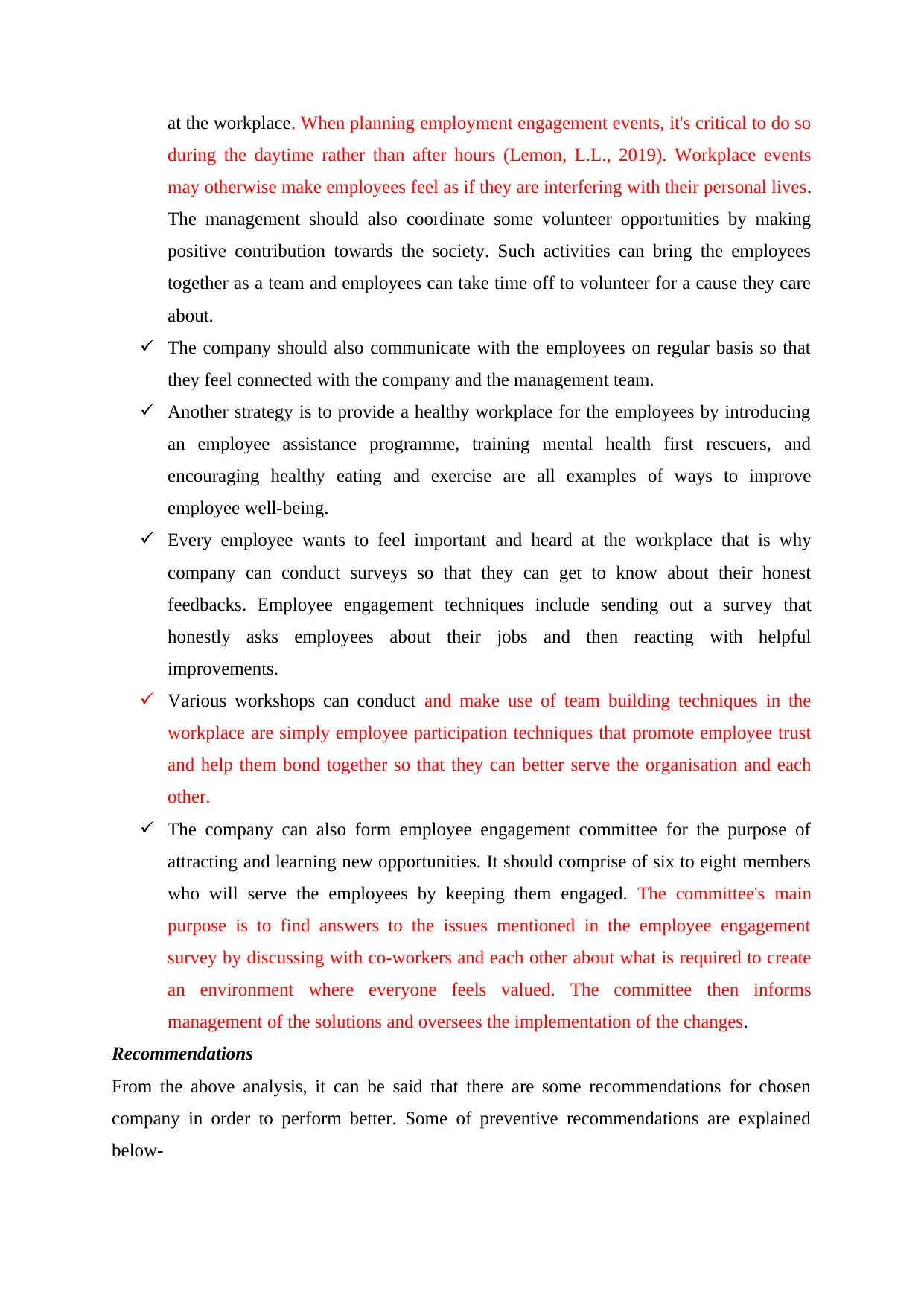
at the workplace. When planning employment engagement events, it's critical to do so
during the daytime rather than after hours (Lemon, L.L., 2019). Workplace events
may otherwise make employees feel as if they are interfering with their personal lives.
The management should also coordinate some volunteer opportunities by making
positive contribution towards the society. Such activities can bring the employees
together as a team and employees can take time off to volunteer for a cause they care
about.
The company should also communicate with the employees on regular basis so that
they feel connected with the company and the management team.
Another strategy is to provide a healthy workplace for the employees by introducing
an employee assistance programme, training mental health first rescuers, and
encouraging healthy eating and exercise are all examples of ways to improve
employee well-being.
Every employee wants to feel important and heard at the workplace that is why
company can conduct surveys so that they can get to know about their honest
feedbacks. Employee engagement techniques include sending out a survey that
honestly asks employees about their jobs and then reacting with helpful
improvements.
Various workshops can conduct and make use of team building techniques in the
workplace are simply employee participation techniques that promote employee trust
and help them bond together so that they can better serve the organisation and each
other.
The company can also form employee engagement committee for the purpose of
attracting and learning new opportunities. It should comprise of six to eight members
who will serve the employees by keeping them engaged. The committee's main
purpose is to find answers to the issues mentioned in the employee engagement
survey by discussing with co-workers and each other about what is required to create
an environment where everyone feels valued. The committee then informs
management of the solutions and oversees the implementation of the changes.
Recommendations
From the above analysis, it can be said that there are some recommendations for chosen
company in order to perform better. Some of preventive recommendations are explained
below-
during the daytime rather than after hours (Lemon, L.L., 2019). Workplace events
may otherwise make employees feel as if they are interfering with their personal lives.
The management should also coordinate some volunteer opportunities by making
positive contribution towards the society. Such activities can bring the employees
together as a team and employees can take time off to volunteer for a cause they care
about.
The company should also communicate with the employees on regular basis so that
they feel connected with the company and the management team.
Another strategy is to provide a healthy workplace for the employees by introducing
an employee assistance programme, training mental health first rescuers, and
encouraging healthy eating and exercise are all examples of ways to improve
employee well-being.
Every employee wants to feel important and heard at the workplace that is why
company can conduct surveys so that they can get to know about their honest
feedbacks. Employee engagement techniques include sending out a survey that
honestly asks employees about their jobs and then reacting with helpful
improvements.
Various workshops can conduct and make use of team building techniques in the
workplace are simply employee participation techniques that promote employee trust
and help them bond together so that they can better serve the organisation and each
other.
The company can also form employee engagement committee for the purpose of
attracting and learning new opportunities. It should comprise of six to eight members
who will serve the employees by keeping them engaged. The committee's main
purpose is to find answers to the issues mentioned in the employee engagement
survey by discussing with co-workers and each other about what is required to create
an environment where everyone feels valued. The committee then informs
management of the solutions and oversees the implementation of the changes.
Recommendations
From the above analysis, it can be said that there are some recommendations for chosen
company in order to perform better. Some of preventive recommendations are explained
below-
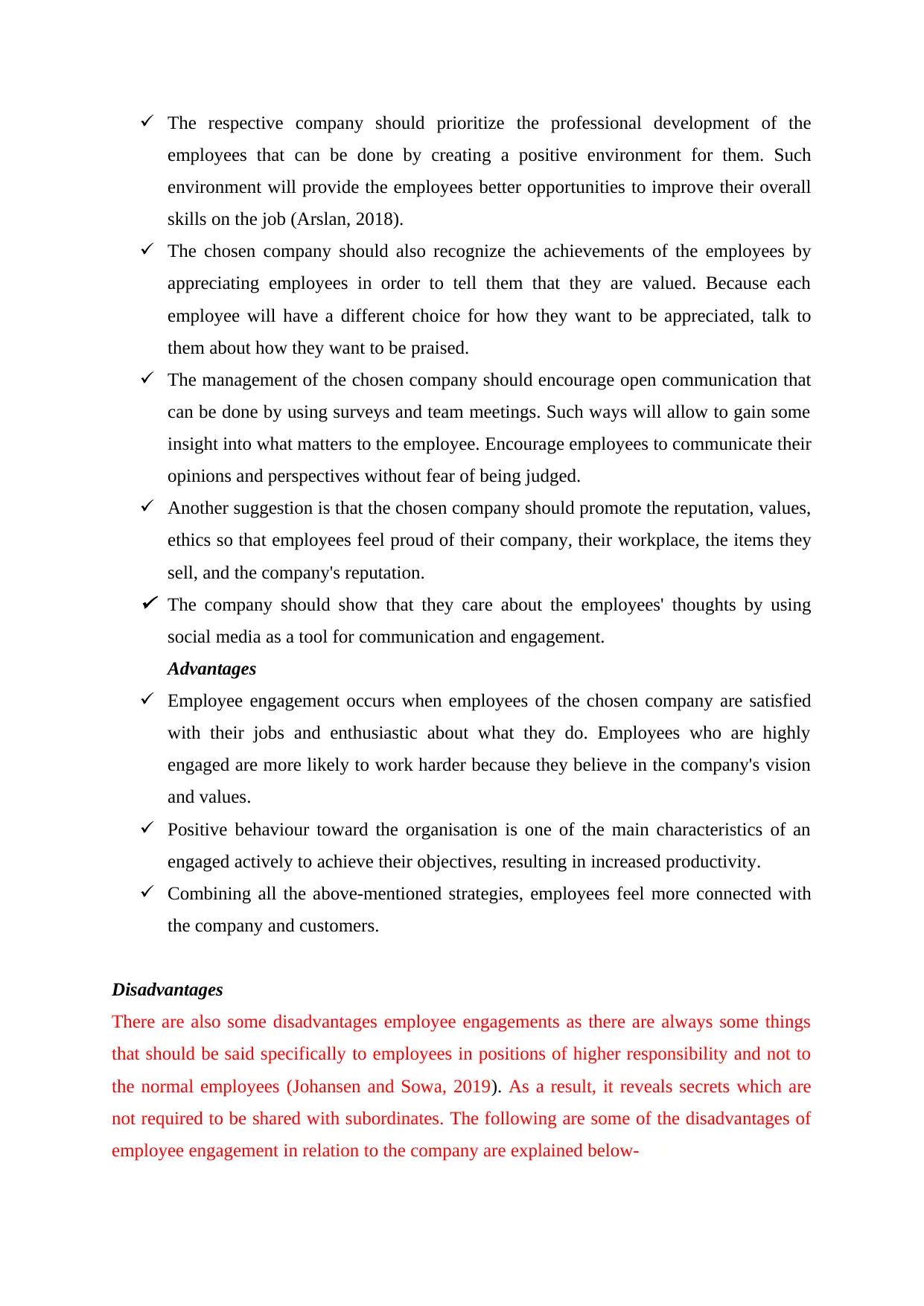
The respective company should prioritize the professional development of the
employees that can be done by creating a positive environment for them. Such
environment will provide the employees better opportunities to improve their overall
skills on the job (Arslan, 2018).
The chosen company should also recognize the achievements of the employees by
appreciating employees in order to tell them that they are valued. Because each
employee will have a different choice for how they want to be appreciated, talk to
them about how they want to be praised.
The management of the chosen company should encourage open communication that
can be done by using surveys and team meetings. Such ways will allow to gain some
insight into what matters to the employee. Encourage employees to communicate their
opinions and perspectives without fear of being judged.
Another suggestion is that the chosen company should promote the reputation, values,
ethics so that employees feel proud of their company, their workplace, the items they
sell, and the company's reputation. The company should show that they care about the employees' thoughts by using
social media as a tool for communication and engagement.
Advantages
Employee engagement occurs when employees of the chosen company are satisfied
with their jobs and enthusiastic about what they do. Employees who are highly
engaged are more likely to work harder because they believe in the company's vision
and values.
Positive behaviour toward the organisation is one of the main characteristics of an
engaged actively to achieve their objectives, resulting in increased productivity.
Combining all the above-mentioned strategies, employees feel more connected with
the company and customers.
Disadvantages
There are also some disadvantages employee engagements as there are always some things
that should be said specifically to employees in positions of higher responsibility and not to
the normal employees (Johansen and Sowa, 2019). As a result, it reveals secrets which are
not required to be shared with subordinates. The following are some of the disadvantages of
employee engagement in relation to the company are explained below-
employees that can be done by creating a positive environment for them. Such
environment will provide the employees better opportunities to improve their overall
skills on the job (Arslan, 2018).
The chosen company should also recognize the achievements of the employees by
appreciating employees in order to tell them that they are valued. Because each
employee will have a different choice for how they want to be appreciated, talk to
them about how they want to be praised.
The management of the chosen company should encourage open communication that
can be done by using surveys and team meetings. Such ways will allow to gain some
insight into what matters to the employee. Encourage employees to communicate their
opinions and perspectives without fear of being judged.
Another suggestion is that the chosen company should promote the reputation, values,
ethics so that employees feel proud of their company, their workplace, the items they
sell, and the company's reputation. The company should show that they care about the employees' thoughts by using
social media as a tool for communication and engagement.
Advantages
Employee engagement occurs when employees of the chosen company are satisfied
with their jobs and enthusiastic about what they do. Employees who are highly
engaged are more likely to work harder because they believe in the company's vision
and values.
Positive behaviour toward the organisation is one of the main characteristics of an
engaged actively to achieve their objectives, resulting in increased productivity.
Combining all the above-mentioned strategies, employees feel more connected with
the company and customers.
Disadvantages
There are also some disadvantages employee engagements as there are always some things
that should be said specifically to employees in positions of higher responsibility and not to
the normal employees (Johansen and Sowa, 2019). As a result, it reveals secrets which are
not required to be shared with subordinates. The following are some of the disadvantages of
employee engagement in relation to the company are explained below-
⊘ This is a preview!⊘
Do you want full access?
Subscribe today to unlock all pages.

Trusted by 1+ million students worldwide
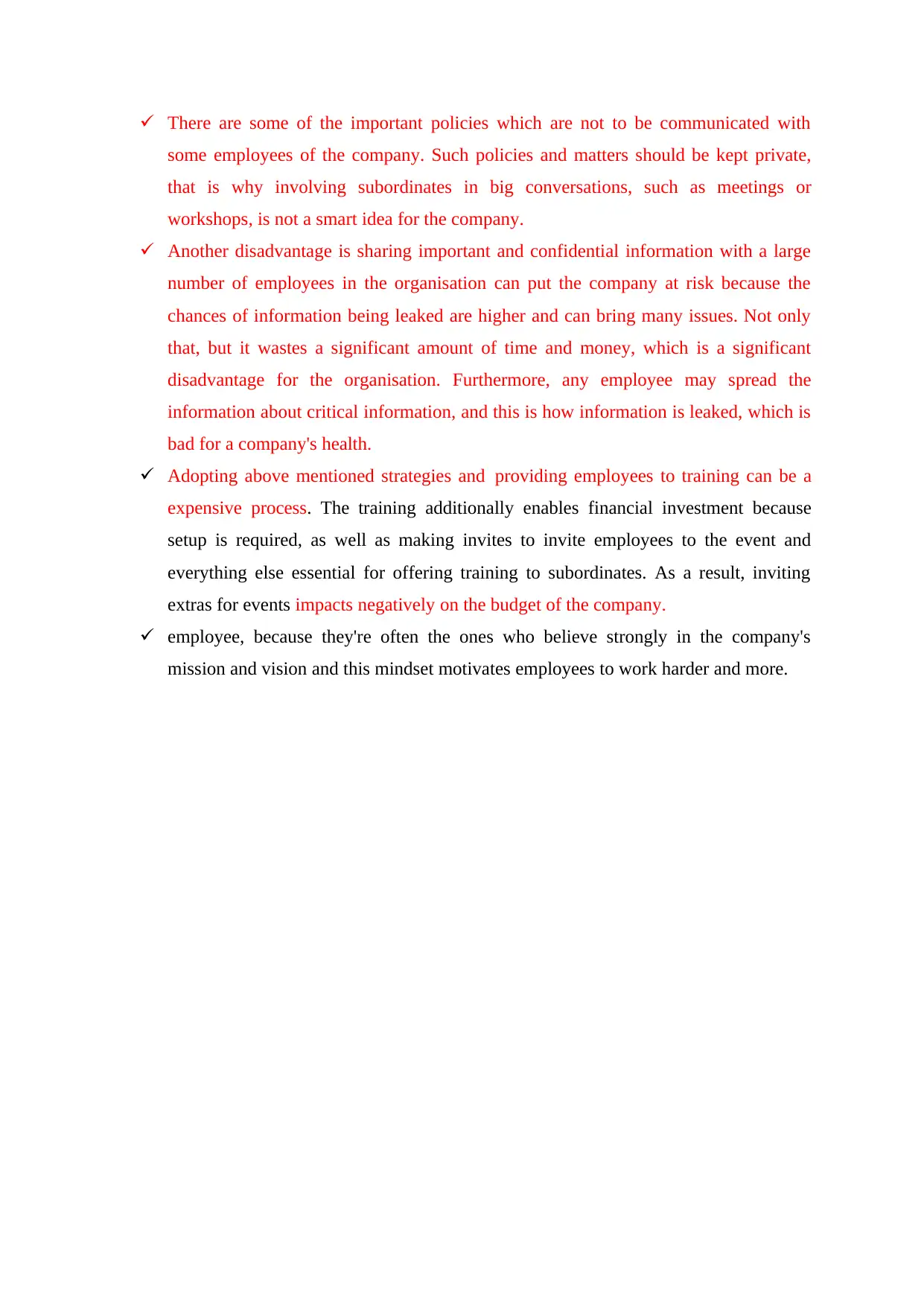
There are some of the important policies which are not to be communicated with
some employees of the company. Such policies and matters should be kept private,
that is why involving subordinates in big conversations, such as meetings or
workshops, is not a smart idea for the company.
Another disadvantage is sharing important and confidential information with a large
number of employees in the organisation can put the company at risk because the
chances of information being leaked are higher and can bring many issues. Not only
that, but it wastes a significant amount of time and money, which is a significant
disadvantage for the organisation. Furthermore, any employee may spread the
information about critical information, and this is how information is leaked, which is
bad for a company's health.
Adopting above mentioned strategies and providing employees to training can be a
expensive process. The training additionally enables financial investment because
setup is required, as well as making invites to invite employees to the event and
everything else essential for offering training to subordinates. As a result, inviting
extras for events impacts negatively on the budget of the company.
employee, because they're often the ones who believe strongly in the company's
mission and vision and this mindset motivates employees to work harder and more.
some employees of the company. Such policies and matters should be kept private,
that is why involving subordinates in big conversations, such as meetings or
workshops, is not a smart idea for the company.
Another disadvantage is sharing important and confidential information with a large
number of employees in the organisation can put the company at risk because the
chances of information being leaked are higher and can bring many issues. Not only
that, but it wastes a significant amount of time and money, which is a significant
disadvantage for the organisation. Furthermore, any employee may spread the
information about critical information, and this is how information is leaked, which is
bad for a company's health.
Adopting above mentioned strategies and providing employees to training can be a
expensive process. The training additionally enables financial investment because
setup is required, as well as making invites to invite employees to the event and
everything else essential for offering training to subordinates. As a result, inviting
extras for events impacts negatively on the budget of the company.
employee, because they're often the ones who believe strongly in the company's
mission and vision and this mindset motivates employees to work harder and more.
Paraphrase This Document
Need a fresh take? Get an instant paraphrase of this document with our AI Paraphraser
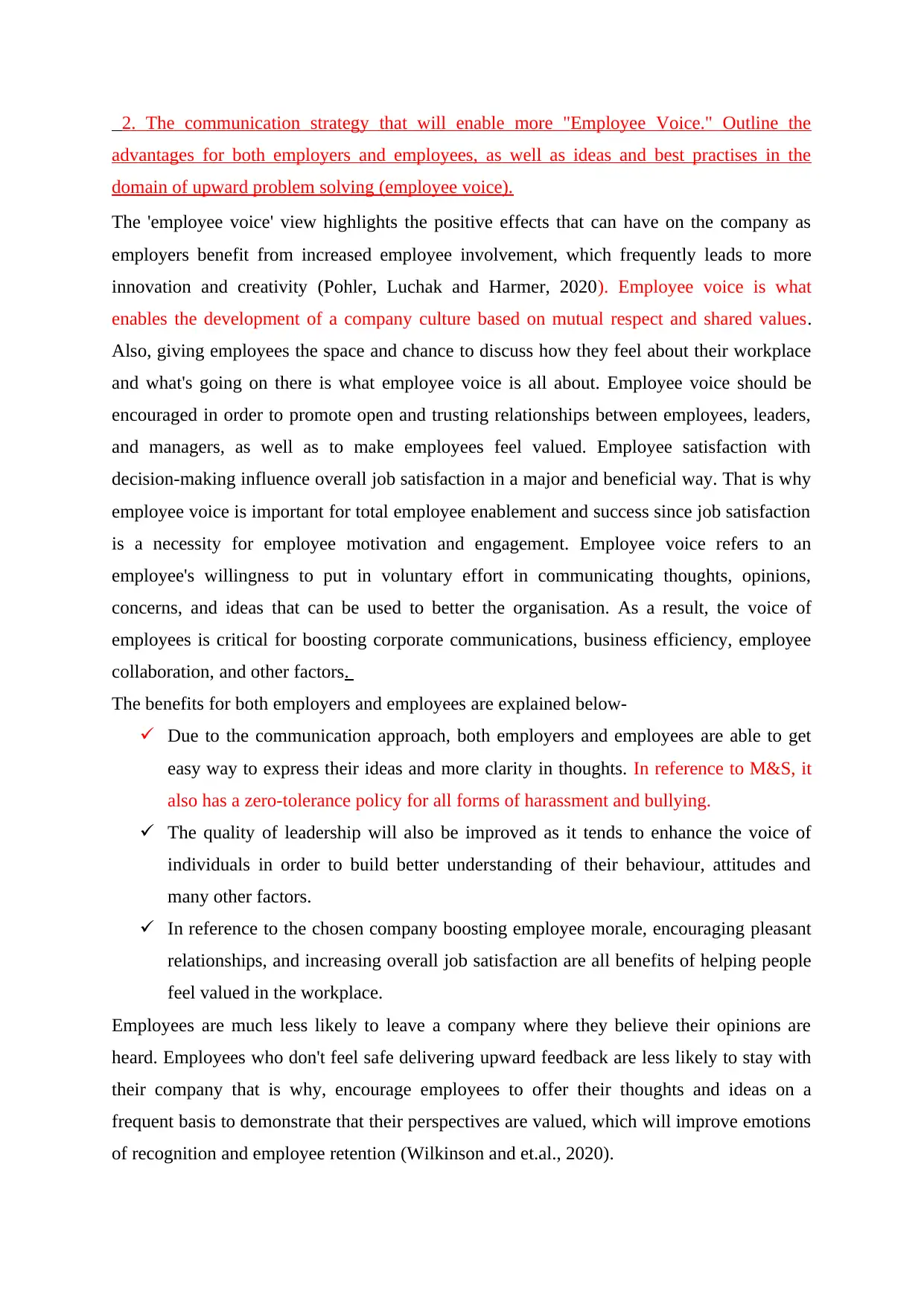
2. The communication strategy that will enable more "Employee Voice." Outline the
advantages for both employers and employees, as well as ideas and best practises in the
domain of upward problem solving (employee voice).
The 'employee voice' view highlights the positive effects that can have on the company as
employers benefit from increased employee involvement, which frequently leads to more
innovation and creativity (Pohler, Luchak and Harmer, 2020). Employee voice is what
enables the development of a company culture based on mutual respect and shared values.
Also, giving employees the space and chance to discuss how they feel about their workplace
and what's going on there is what employee voice is all about. Employee voice should be
encouraged in order to promote open and trusting relationships between employees, leaders,
and managers, as well as to make employees feel valued. Employee satisfaction with
decision-making influence overall job satisfaction in a major and beneficial way. That is why
employee voice is important for total employee enablement and success since job satisfaction
is a necessity for employee motivation and engagement. Employee voice refers to an
employee's willingness to put in voluntary effort in communicating thoughts, opinions,
concerns, and ideas that can be used to better the organisation. As a result, the voice of
employees is critical for boosting corporate communications, business efficiency, employee
collaboration, and other factors.
The benefits for both employers and employees are explained below-
Due to the communication approach, both employers and employees are able to get
easy way to express their ideas and more clarity in thoughts. In reference to M&S, it
also has a zero-tolerance policy for all forms of harassment and bullying.
The quality of leadership will also be improved as it tends to enhance the voice of
individuals in order to build better understanding of their behaviour, attitudes and
many other factors.
In reference to the chosen company boosting employee morale, encouraging pleasant
relationships, and increasing overall job satisfaction are all benefits of helping people
feel valued in the workplace.
Employees are much less likely to leave a company where they believe their opinions are
heard. Employees who don't feel safe delivering upward feedback are less likely to stay with
their company that is why, encourage employees to offer their thoughts and ideas on a
frequent basis to demonstrate that their perspectives are valued, which will improve emotions
of recognition and employee retention (Wilkinson and et.al., 2020).
advantages for both employers and employees, as well as ideas and best practises in the
domain of upward problem solving (employee voice).
The 'employee voice' view highlights the positive effects that can have on the company as
employers benefit from increased employee involvement, which frequently leads to more
innovation and creativity (Pohler, Luchak and Harmer, 2020). Employee voice is what
enables the development of a company culture based on mutual respect and shared values.
Also, giving employees the space and chance to discuss how they feel about their workplace
and what's going on there is what employee voice is all about. Employee voice should be
encouraged in order to promote open and trusting relationships between employees, leaders,
and managers, as well as to make employees feel valued. Employee satisfaction with
decision-making influence overall job satisfaction in a major and beneficial way. That is why
employee voice is important for total employee enablement and success since job satisfaction
is a necessity for employee motivation and engagement. Employee voice refers to an
employee's willingness to put in voluntary effort in communicating thoughts, opinions,
concerns, and ideas that can be used to better the organisation. As a result, the voice of
employees is critical for boosting corporate communications, business efficiency, employee
collaboration, and other factors.
The benefits for both employers and employees are explained below-
Due to the communication approach, both employers and employees are able to get
easy way to express their ideas and more clarity in thoughts. In reference to M&S, it
also has a zero-tolerance policy for all forms of harassment and bullying.
The quality of leadership will also be improved as it tends to enhance the voice of
individuals in order to build better understanding of their behaviour, attitudes and
many other factors.
In reference to the chosen company boosting employee morale, encouraging pleasant
relationships, and increasing overall job satisfaction are all benefits of helping people
feel valued in the workplace.
Employees are much less likely to leave a company where they believe their opinions are
heard. Employees who don't feel safe delivering upward feedback are less likely to stay with
their company that is why, encourage employees to offer their thoughts and ideas on a
frequent basis to demonstrate that their perspectives are valued, which will improve emotions
of recognition and employee retention (Wilkinson and et.al., 2020).
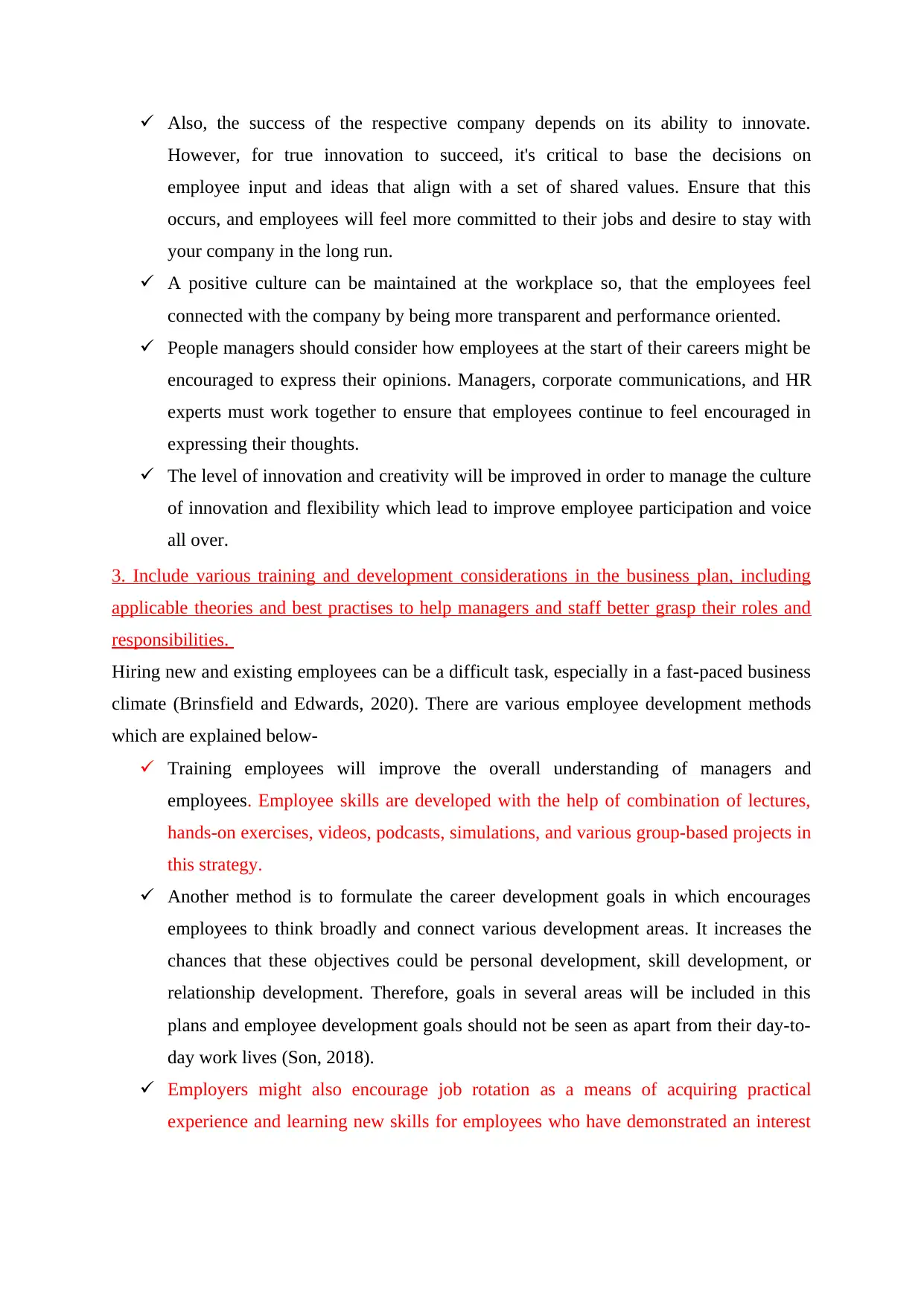
Also, the success of the respective company depends on its ability to innovate.
However, for true innovation to succeed, it's critical to base the decisions on
employee input and ideas that align with a set of shared values. Ensure that this
occurs, and employees will feel more committed to their jobs and desire to stay with
your company in the long run.
A positive culture can be maintained at the workplace so, that the employees feel
connected with the company by being more transparent and performance oriented.
People managers should consider how employees at the start of their careers might be
encouraged to express their opinions. Managers, corporate communications, and HR
experts must work together to ensure that employees continue to feel encouraged in
expressing their thoughts.
The level of innovation and creativity will be improved in order to manage the culture
of innovation and flexibility which lead to improve employee participation and voice
all over.
3. Include various training and development considerations in the business plan, including
applicable theories and best practises to help managers and staff better grasp their roles and
responsibilities.
Hiring new and existing employees can be a difficult task, especially in a fast-paced business
climate (Brinsfield and Edwards, 2020). There are various employee development methods
which are explained below-
Training employees will improve the overall understanding of managers and
employees. Employee skills are developed with the help of combination of lectures,
hands-on exercises, videos, podcasts, simulations, and various group-based projects in
this strategy.
Another method is to formulate the career development goals in which encourages
employees to think broadly and connect various development areas. It increases the
chances that these objectives could be personal development, skill development, or
relationship development. Therefore, goals in several areas will be included in this
plans and employee development goals should not be seen as apart from their day-to-
day work lives (Son, 2018).
Employers might also encourage job rotation as a means of acquiring practical
experience and learning new skills for employees who have demonstrated an interest
However, for true innovation to succeed, it's critical to base the decisions on
employee input and ideas that align with a set of shared values. Ensure that this
occurs, and employees will feel more committed to their jobs and desire to stay with
your company in the long run.
A positive culture can be maintained at the workplace so, that the employees feel
connected with the company by being more transparent and performance oriented.
People managers should consider how employees at the start of their careers might be
encouraged to express their opinions. Managers, corporate communications, and HR
experts must work together to ensure that employees continue to feel encouraged in
expressing their thoughts.
The level of innovation and creativity will be improved in order to manage the culture
of innovation and flexibility which lead to improve employee participation and voice
all over.
3. Include various training and development considerations in the business plan, including
applicable theories and best practises to help managers and staff better grasp their roles and
responsibilities.
Hiring new and existing employees can be a difficult task, especially in a fast-paced business
climate (Brinsfield and Edwards, 2020). There are various employee development methods
which are explained below-
Training employees will improve the overall understanding of managers and
employees. Employee skills are developed with the help of combination of lectures,
hands-on exercises, videos, podcasts, simulations, and various group-based projects in
this strategy.
Another method is to formulate the career development goals in which encourages
employees to think broadly and connect various development areas. It increases the
chances that these objectives could be personal development, skill development, or
relationship development. Therefore, goals in several areas will be included in this
plans and employee development goals should not be seen as apart from their day-to-
day work lives (Son, 2018).
Employers might also encourage job rotation as a means of acquiring practical
experience and learning new skills for employees who have demonstrated an interest
⊘ This is a preview!⊘
Do you want full access?
Subscribe today to unlock all pages.

Trusted by 1+ million students worldwide
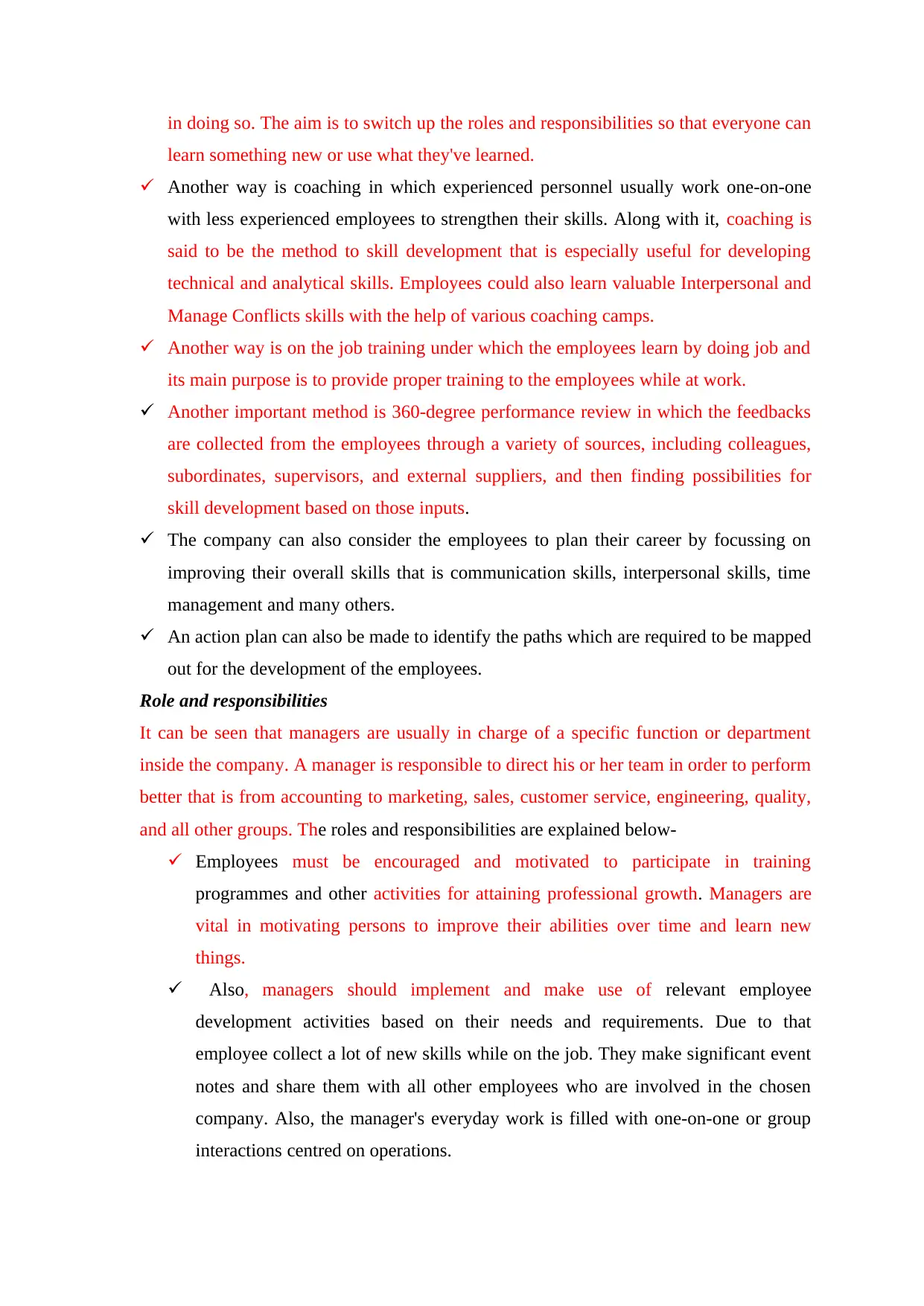
in doing so. The aim is to switch up the roles and responsibilities so that everyone can
learn something new or use what they've learned.
Another way is coaching in which experienced personnel usually work one-on-one
with less experienced employees to strengthen their skills. Along with it, coaching is
said to be the method to skill development that is especially useful for developing
technical and analytical skills. Employees could also learn valuable Interpersonal and
Manage Conflicts skills with the help of various coaching camps.
Another way is on the job training under which the employees learn by doing job and
its main purpose is to provide proper training to the employees while at work.
Another important method is 360-degree performance review in which the feedbacks
are collected from the employees through a variety of sources, including colleagues,
subordinates, supervisors, and external suppliers, and then finding possibilities for
skill development based on those inputs.
The company can also consider the employees to plan their career by focussing on
improving their overall skills that is communication skills, interpersonal skills, time
management and many others.
An action plan can also be made to identify the paths which are required to be mapped
out for the development of the employees.
Role and responsibilities
It can be seen that managers are usually in charge of a specific function or department
inside the company. A manager is responsible to direct his or her team in order to perform
better that is from accounting to marketing, sales, customer service, engineering, quality,
and all other groups. The roles and responsibilities are explained below-
Employees must be encouraged and motivated to participate in training
programmes and other activities for attaining professional growth. Managers are
vital in motivating persons to improve their abilities over time and learn new
things.
Also, managers should implement and make use of relevant employee
development activities based on their needs and requirements. Due to that
employee collect a lot of new skills while on the job. They make significant event
notes and share them with all other employees who are involved in the chosen
company. Also, the manager's everyday work is filled with one-on-one or group
interactions centred on operations.
learn something new or use what they've learned.
Another way is coaching in which experienced personnel usually work one-on-one
with less experienced employees to strengthen their skills. Along with it, coaching is
said to be the method to skill development that is especially useful for developing
technical and analytical skills. Employees could also learn valuable Interpersonal and
Manage Conflicts skills with the help of various coaching camps.
Another way is on the job training under which the employees learn by doing job and
its main purpose is to provide proper training to the employees while at work.
Another important method is 360-degree performance review in which the feedbacks
are collected from the employees through a variety of sources, including colleagues,
subordinates, supervisors, and external suppliers, and then finding possibilities for
skill development based on those inputs.
The company can also consider the employees to plan their career by focussing on
improving their overall skills that is communication skills, interpersonal skills, time
management and many others.
An action plan can also be made to identify the paths which are required to be mapped
out for the development of the employees.
Role and responsibilities
It can be seen that managers are usually in charge of a specific function or department
inside the company. A manager is responsible to direct his or her team in order to perform
better that is from accounting to marketing, sales, customer service, engineering, quality,
and all other groups. The roles and responsibilities are explained below-
Employees must be encouraged and motivated to participate in training
programmes and other activities for attaining professional growth. Managers are
vital in motivating persons to improve their abilities over time and learn new
things.
Also, managers should implement and make use of relevant employee
development activities based on their needs and requirements. Due to that
employee collect a lot of new skills while on the job. They make significant event
notes and share them with all other employees who are involved in the chosen
company. Also, the manager's everyday work is filled with one-on-one or group
interactions centred on operations.
Paraphrase This Document
Need a fresh take? Get an instant paraphrase of this document with our AI Paraphraser
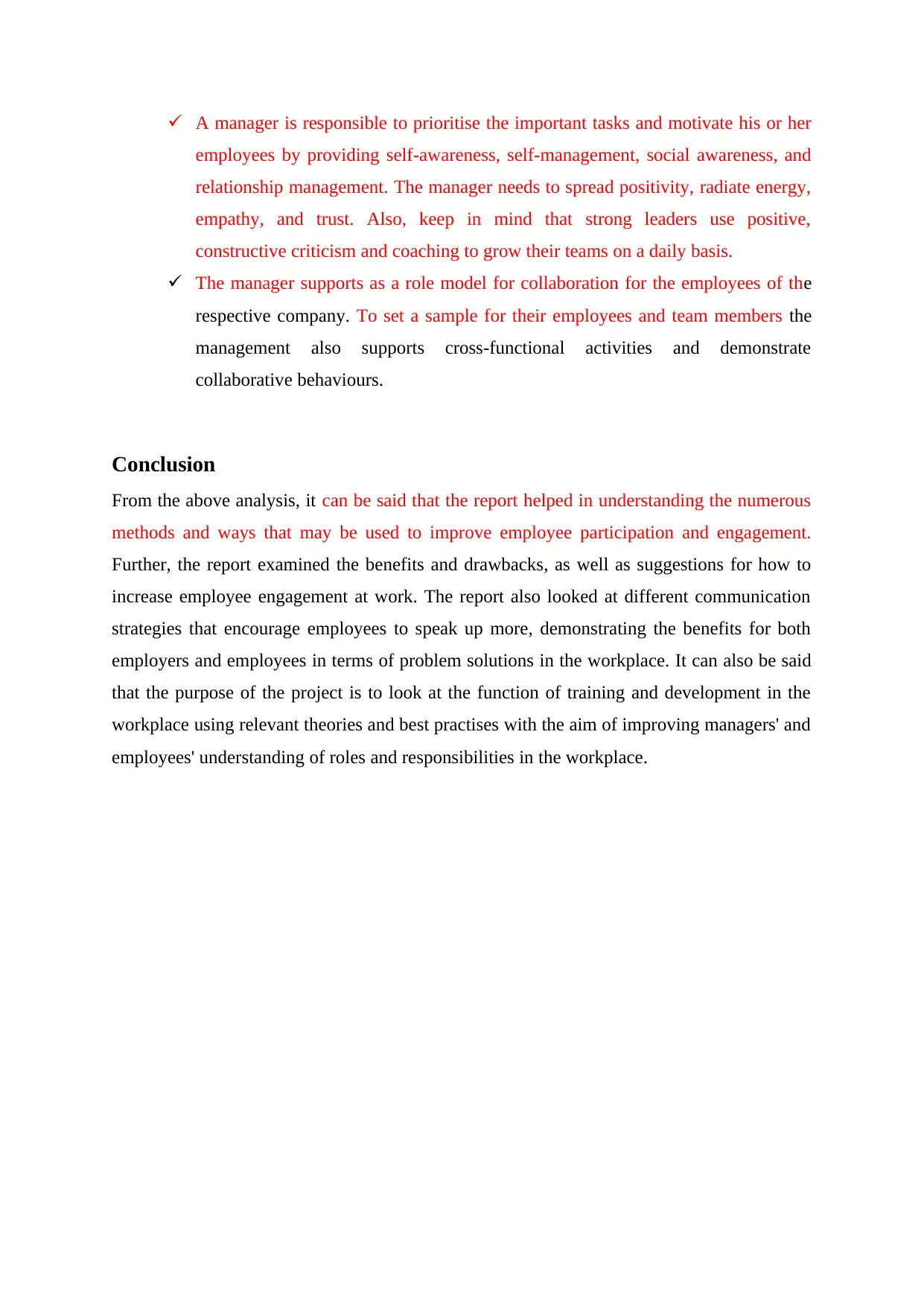
A manager is responsible to prioritise the important tasks and motivate his or her
employees by providing self-awareness, self-management, social awareness, and
relationship management. The manager needs to spread positivity, radiate energy,
empathy, and trust. Also, keep in mind that strong leaders use positive,
constructive criticism and coaching to grow their teams on a daily basis.
The manager supports as a role model for collaboration for the employees of the
respective company. To set a sample for their employees and team members the
management also supports cross-functional activities and demonstrate
collaborative behaviours.
Conclusion
From the above analysis, it can be said that the report helped in understanding the numerous
methods and ways that may be used to improve employee participation and engagement.
Further, the report examined the benefits and drawbacks, as well as suggestions for how to
increase employee engagement at work. The report also looked at different communication
strategies that encourage employees to speak up more, demonstrating the benefits for both
employers and employees in terms of problem solutions in the workplace. It can also be said
that the purpose of the project is to look at the function of training and development in the
workplace using relevant theories and best practises with the aim of improving managers' and
employees' understanding of roles and responsibilities in the workplace.
employees by providing self-awareness, self-management, social awareness, and
relationship management. The manager needs to spread positivity, radiate energy,
empathy, and trust. Also, keep in mind that strong leaders use positive,
constructive criticism and coaching to grow their teams on a daily basis.
The manager supports as a role model for collaboration for the employees of the
respective company. To set a sample for their employees and team members the
management also supports cross-functional activities and demonstrate
collaborative behaviours.
Conclusion
From the above analysis, it can be said that the report helped in understanding the numerous
methods and ways that may be used to improve employee participation and engagement.
Further, the report examined the benefits and drawbacks, as well as suggestions for how to
increase employee engagement at work. The report also looked at different communication
strategies that encourage employees to speak up more, demonstrating the benefits for both
employers and employees in terms of problem solutions in the workplace. It can also be said
that the purpose of the project is to look at the function of training and development in the
workplace using relevant theories and best practises with the aim of improving managers' and
employees' understanding of roles and responsibilities in the workplace.
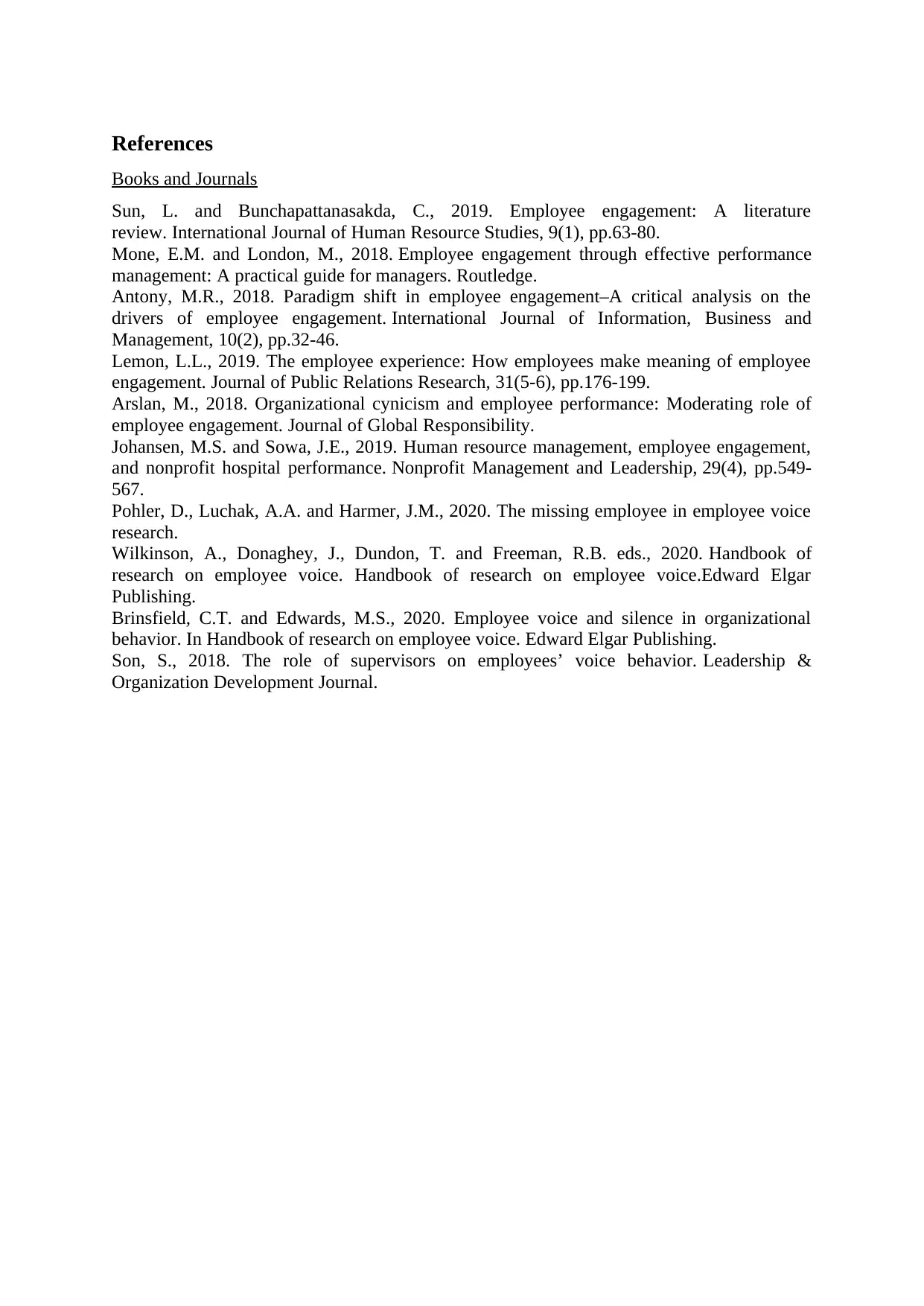
References
Books and Journals
Sun, L. and Bunchapattanasakda, C., 2019. Employee engagement: A literature
review. International Journal of Human Resource Studies, 9(1), pp.63-80.
Mone, E.M. and London, M., 2018. Employee engagement through effective performance
management: A practical guide for managers. Routledge.
Antony, M.R., 2018. Paradigm shift in employee engagement–A critical analysis on the
drivers of employee engagement. International Journal of Information, Business and
Management, 10(2), pp.32-46.
Lemon, L.L., 2019. The employee experience: How employees make meaning of employee
engagement. Journal of Public Relations Research, 31(5-6), pp.176-199.
Arslan, M., 2018. Organizational cynicism and employee performance: Moderating role of
employee engagement. Journal of Global Responsibility.
Johansen, M.S. and Sowa, J.E., 2019. Human resource management, employee engagement,
and nonprofit hospital performance. Nonprofit Management and Leadership, 29(4), pp.549-
567.
Pohler, D., Luchak, A.A. and Harmer, J.M., 2020. The missing employee in employee voice
research.
Wilkinson, A., Donaghey, J., Dundon, T. and Freeman, R.B. eds., 2020. Handbook of
research on employee voice. Handbook of research on employee voice.Edward Elgar
Publishing.
Brinsfield, C.T. and Edwards, M.S., 2020. Employee voice and silence in organizational
behavior. In Handbook of research on employee voice. Edward Elgar Publishing.
Son, S., 2018. The role of supervisors on employees’ voice behavior. Leadership &
Organization Development Journal.
Books and Journals
Sun, L. and Bunchapattanasakda, C., 2019. Employee engagement: A literature
review. International Journal of Human Resource Studies, 9(1), pp.63-80.
Mone, E.M. and London, M., 2018. Employee engagement through effective performance
management: A practical guide for managers. Routledge.
Antony, M.R., 2018. Paradigm shift in employee engagement–A critical analysis on the
drivers of employee engagement. International Journal of Information, Business and
Management, 10(2), pp.32-46.
Lemon, L.L., 2019. The employee experience: How employees make meaning of employee
engagement. Journal of Public Relations Research, 31(5-6), pp.176-199.
Arslan, M., 2018. Organizational cynicism and employee performance: Moderating role of
employee engagement. Journal of Global Responsibility.
Johansen, M.S. and Sowa, J.E., 2019. Human resource management, employee engagement,
and nonprofit hospital performance. Nonprofit Management and Leadership, 29(4), pp.549-
567.
Pohler, D., Luchak, A.A. and Harmer, J.M., 2020. The missing employee in employee voice
research.
Wilkinson, A., Donaghey, J., Dundon, T. and Freeman, R.B. eds., 2020. Handbook of
research on employee voice. Handbook of research on employee voice.Edward Elgar
Publishing.
Brinsfield, C.T. and Edwards, M.S., 2020. Employee voice and silence in organizational
behavior. In Handbook of research on employee voice. Edward Elgar Publishing.
Son, S., 2018. The role of supervisors on employees’ voice behavior. Leadership &
Organization Development Journal.
⊘ This is a preview!⊘
Do you want full access?
Subscribe today to unlock all pages.

Trusted by 1+ million students worldwide
1 out of 12
Related Documents
Your All-in-One AI-Powered Toolkit for Academic Success.
+13062052269
info@desklib.com
Available 24*7 on WhatsApp / Email
![[object Object]](/_next/static/media/star-bottom.7253800d.svg)
Unlock your academic potential
Copyright © 2020–2025 A2Z Services. All Rights Reserved. Developed and managed by ZUCOL.



